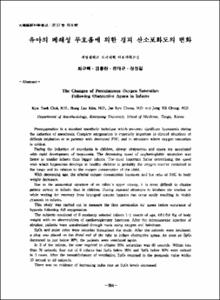KUMEL Repository
1. Journal Papers (연구논문)
1. School of Medicine (의과대학)
Dept. of Anesthesiology & Pain Medicine (마취통증의학)
유아의 폐쇄성 무호흡에 의한 경피 산소포화도의 변화
- Keimyung Author(s)
- Choi, Kyu Taek; Cheun, Jae Kyu; Chung, Jung Kil
- Journal Title
- 대한마취과학회지
- Issued Date
- 1994
- Volume
- 27
- Issue
- 8
- Abstract
- Preoxygenation is a standard anesthetic technique which prevents significant hypoxemia during the induction of anesthesia. Complete oxygenation is especially important in clinical situations of difficult intubation or in patients with decreased FRC, and in siturations where oxygen saturation is critical. During the induction of anesthesia in children, airway obstruction and apnea are associated with rapid development of hypoxemia. The decreasing speed of oxyhemoglobin saturation was faster in smaller infants than bigger infants. The most important factor determining the speed with which hypoxemia develops in healthy children is probably the oxygen reserve contained in the lungs and its relation to the oxygen consumption of the child. With deaeasing age, the arterial oxygen consumption increases and the ratio of FRC to body weight decreases. Due to the anatomical structure of an infant's upper airway, it is more difficult to obtaine patient airway in infants than in children. During repeated atttempts to intubate the trachea or while waiting for recovery from laryngeal spasms hypoxia can occur easily resulting in visible cyanosis in infants. This study was carried out to measure the time permissible for apnea before occurance of hypoxia following full oxygenation. The subjects consisted of 6 randomly selected infants 1-2 month of age, 4.6±0.6 Kg of body weight with no abnormalities of cardiorespiratory functions. After the intramuscular injection of atropine, patients were anesthetized through mask using oxygen and halothane. SpO2 and pulse rates were recorded throughout the study. After the patients were intubated, a plug was placed on the distal end of the tube to induce obstructive apnea. As soon as SpO2 decreased to just below 90%, the patients were ventilated again. In 2 of the infants, the time required to obtaine 90% saturation was 60 seconds. Within less than 70 seconds, four out of 6 infants had SpO2 below 90% and SpO2 below 80% were noticed in 3 cases. After the reestablishment of ventilation, SpO2 returned to the preapneic value within 10 second in all subjects. There was no evidence of increasing pulse rate as SpO2 levels decreased. However, pulse rate decreased in all subjects thoughout the study. In summary, maximum time permissible for apnea in neonate and young infant is approximately one minute. Furthermore, tachycardia should not be used as a sign for the onset of hypoxia.
생후 1~2개월된 미국 마취과학회 분류 1-2에 속 하는 유아 6명을 대상으로 하여 기도확보에 필요한 안전한 무호흡기간을 추정하기 위하여 인위적으로 폐쇄성 무호흡을 유도하여 다음과 같은 결과를 얻 었다.
1) 안전한 무호홉기간은 1분 정도로 예상되었다.
2) 저산소증에 처하기전 빈맥시기가 없이 바로 서맥이 일어났다. 이것으로 무호홉상태에서는 빈맥 관찰이 저산소증올 인지하는 정확한 지표가 되지않음을 알수 있었다.
- Alternative Title
- The Changes of Percutaneous Oxygen Saturation Following Obstructive Apnea in Infants
- Publisher
- School of Medicine
- Citation
- 최규택 et al. (1994). 유아의 폐쇄성 무호흡에 의한 경피 산소포화도의 변화. 대한마취과학회지, 27(8), 984–989. doi: 10.4097/kjae.1994.27.8.984
- Type
- Article
- ISSN
- 0302-5780
- Appears in Collections:
- 1. School of Medicine (의과대학) > Dept. of Anesthesiology & Pain Medicine (마취통증의학)
- 파일 목록
-
-
Download
 oak-bbb-797.pdf
기타 데이터 / 342.01 kB / Adobe PDF
oak-bbb-797.pdf
기타 데이터 / 342.01 kB / Adobe PDF
-
Items in Repository are protected by copyright, with all rights reserved, unless otherwise indicated.